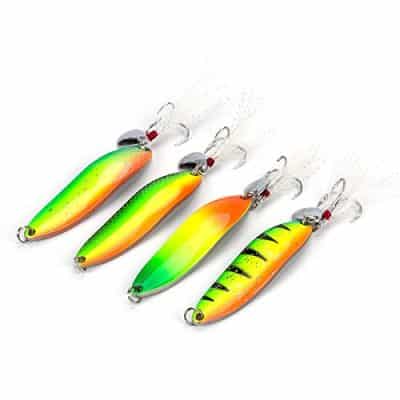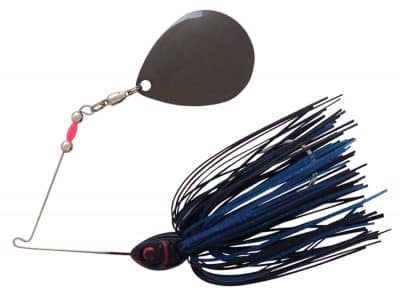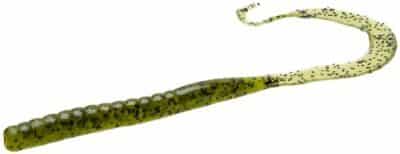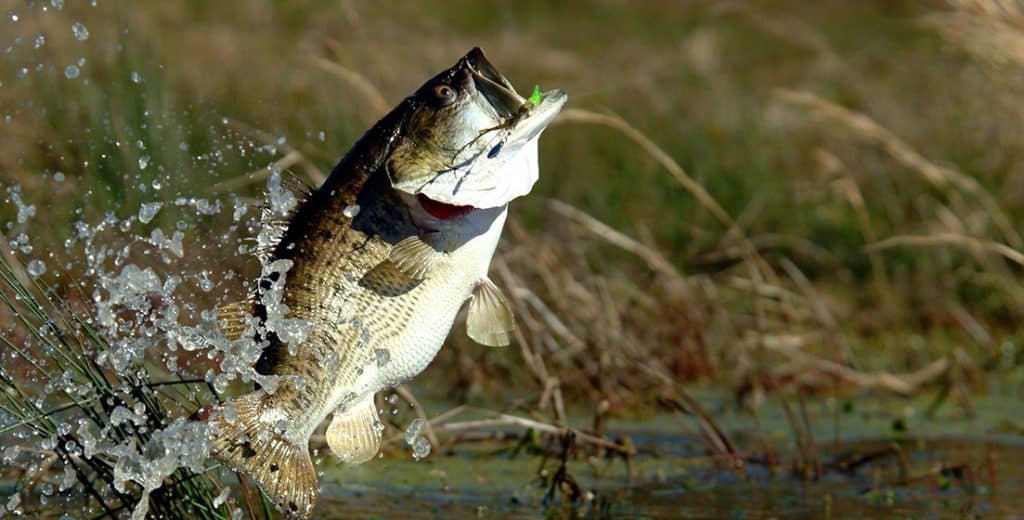Lets face it, everybody loves to catch massive bass. Easily one of the most exciting fresh water fish to catch. With so many bass fisherman out there, you’d think finding bass would be easy.
Fisherman have been after trophy bass for 100s of years, but its still hit or miss. With a few simple techniques you can significantly increase your bass count this year.
Different Bass Fishing Baits
Jigging Spoons
These heavy slabs of lead have long been a top choice for bass fisherman. They might not look to impressive, but they sure do bring in bass.
I love throwing a South Bend Spoon in the fall and winter when bass are deeper in the water.
These simple lures can be used to imitate dying shad. Fisherman have long touted the effectiveness of jigging spoons.
How to Fish Jigging Spoons
Anglers have a hard time figuring out how to actually fish jigging spoons.
Most of the time inexperienced fisherman fish jigging spoons too fast. This causes them to lift off the bottom much to far.
In the fall and winter everything moves a little slower in the colder water. A spoon only needs to be worked a few inches to be effective. This translates into a small almost minimal rod tip movement.
They’re going to be most successful when they fall on a slack line. Try tofollow the lure back down by lowering your rod faster than the lure sinks. Figuring out this technique separates the pros from the amateurs in spoon jigging success.
Strikes tend to come right as the spoon falls on a slack line. You’ve got to watch your line to see it happen. You’ll very rarely be able to feel the strike on a slack line.
Spinnerbaits
Spinnerbaits have always accounted for a large number of trophy bass each year. The extremely versatile design can be used in just about any lake.
Just cast out a your favorite spinnerbait(mines a Strike King Finesse KVD) and quickly work the lake.
Unlike some other baits on this list they’re not relegated to shallow water. Some of todays heavy spinnerbaits can be slow rolled across the bottom following underwater grass or channel breaks.
Why Fish Spinnerbaits For Bass?
The obvious attraction of spinnerbaits is that they produce vibrations and are mostly weedless. They can be fished safely around brush and other debris.
They’re effective throughout most of the year, but you’ll have to change up your strike zone. Thankfully staying in a small strikezone isn’t what spinnerbaits are all about. They’re meant to create fast reactionary strikes using erratic movements during your retrieve.
When do Bass Strike?
Every time your spinnerbait falls or begins to climb, the vibration pattern changes. Most strikes will come immediately after this change in vibration.
You’ll get the most out of a spinnerbait using a yo-yo retrieve. Simply raise your rod tip to make the bait rise then reel in as the spinnerbait falls. Repeat the process all the way back to your boat.
In deep water you should also try the “Ripping” retrieve. When bass are lurking in 30+ feet deep water the fast paced ripping retrieve will lure them out of hiding.
Let your spinnerbait fall to the bottom and quickly jerk your rod tip up at the bottom. Quickly reel in your line, forcing the bait to quickly jump off the bottom. You’ll want a bigger 3/4 oz spinnerbait lure for the “Ripping” technique.
Swim Baits
Swim baits quickly picked up steam in California fishing communities, but they’re rarely used out East.
They’ve long been proven to be extremely effective for trophy bass. My favorite is the Strike King Rage Swimmer Swimbait. They come in a wide variety of colors, but generally resemble natural baitfish.
There’s a wide variety of swim baits made from different materials. From solid soft or hard bodies to multi jointed hard baits. They just need to have a natural life like movement pattern.
How To Fish a Swimbait
The basic presentation is to simply cast the bait and reel it slowly and steadily. Try and make it look like a rainbow trout slowly meandering through the water. You’ll want to use this technique in open water around scattered cover. Swim baits aren’t meant for specific targeting. Since they’re too large to cast with any degree of accuracy try and keep to open waters.
Another popular technique is “deadsticking” in which the lure isn’t moved. This can be done with either a floating or sinking lure left along the bottom. Floating swim baits are often drifted this way along major channel breaks and across wide flats. Surprisingly big fish will come out of deep water to hit them.
Soft Plastics
There are so many different types of soft plastic bait that it’s impossible to list them all. These soft plastic lures, including worms, lizards, craw worms, tubes and loads of “creature baits” are among the most effective trophy lures.
One of my favorites is the 9″ Zoom Magnum II Worm. There are a wide variety of colors to choose from and it’s big enough to catch monster bass.
Most soft lures can be accurately cast to specific targets causing lots of hits. These large lures displace a lot of water making them very noticeable.
How to Fish With Soft Plastics
Soft plastics are effective big bass lures because they look really natural in the water. Fishing them very slowly is sure to entice a monster bass. They can even be rigged weedless for retrieving through brush and vegetation.
If there’s one rule to live by its choose a large lure and fish it slowly. Most big bass experts fish plastic worms from 10-16 inches long, or moderate sized lizards. That doesn’t mean you can’t catch large bass on smaller worms, but you’ll have much more luck on bigger lures. Larger bass don’t feed as often as smaller fish so when they do its normally a larger meal.
Most soft plastic lures are going to be fished on the bottom. One major advantage is that all soft lures can be rigged totally weedless.
Cast them into shadowy places and keep them there. I prefer to fish a long worms using a Texas rigging with or without a pegged sinker. Other rigging options include split-split shotting, Carolina-Rigging, and weightless.
One interesting technique a few anglers have been using is irritating bass with an oversized tube lure. These tubes which can be upwards of 1 inch in diameter aren’t even used with a hook. Due to the difficulty of hooking big bass that barely takes the bait.
Giant tubes are used to irritate the fish until they get upset enough to bite. Once they start biting switch to a smaller lure that’s much easier to hook. Pros have been using this technique to entice monster bass for years.
Golden Shiners
If you’ve done any fishing in Florida you’re most likely accustomed to golden shiners. These oversized minnows make up a massive portion of the local fish diet. Unsurprisingly its one of the most effective baits used in Florida. Golden shiners are found throughout the east coast, but they’re almost exclusively used near Florida.
Shiners are fished under a float using a similar technique for minnow fishing crappie or beam. They are free lined without a float and sometimes trolled. If you don’t have a lot of experience fishing shiners you’ll want to use a float. When fishing heavy cover floats will help you stay out of the weeds. Hook the shiners with a 4/0 or 5/0 hook through the back behind the dorsal fin. Work with a 20-30lb test line with the reel in freespool. Allow the bass to swim with the shiner a few seconds before you set the hook.
When bass are roaming you might want to try trolling shiners. While its done at an extremely slow speed it will allow you to cover a lot of water. Instead of hooking the shiner behind the dorsal fin hook it through the lips. In high traffic areas you’ll want to stop to see if a motionless shiner can attract any bass.
In deeper water you’ll want to try a free-lining technique. It’s not the relaxed fishing you may be used to. It’s an intense technique that requires a lot of practice. You’ll have to watch and feel the line guiding the shiner by line pressure.
Crawfish
Crawfish have long been one of the favorite live baits among bass fisherman. Used mostly in California this is the perfect bait for winter and early spring. Most crawfish are hooked through the tail with a No. 4 Hook from underneath. For a more natural look hook them under the shell between the eyes. You’ll want to use a small split shot with or without floats. Light lines and spinning tackle are generally accepted also.
Cast the crawfish allowing it to sink to the bottom. You can either let it wander on its own along the bottome or slowly pull it along the bottom using a stop and go retrieve. Most pros like to use crawfish along rocks and gravel where crawfish are naturally found. Bass aren’t going to strike the crawfish very hard so you’ll need to watch your line intently.
Topwaters
Top Water lures have long been one of the most effective bass luress. The lures are extremely popular and can be extremely productive. There’s a ton of great topwater lures, but Rebels Pop-R lure is easily my favorite. There are a ton of poppers on the market, but they’re all clones of the Rebel Lure.
You’ll need a big lure if you want to catch monster bass. Big lures will displace more water, create a bigger shadow and use a bigger hook. Topwater lures work best in clear water where bass can rely on both sound and vision.
With a topwater lure you’ll notice that technique is more important than the actual lure. The lure itself may help some, but the speed of retrieve and cadence of motion does most of the work. Normally slow is going to be better. You may even want to leave the lure sit motionless on the surface. You can even fish bigger floating swim baits this way. I personally like to start off with a slow retrieve and gradually accelerate until I get a strike.
Topwater lures can be fished almost anywhere, but some places work better than others. Try working them close to shallow cover or in clear water with deep well defined structures. You can also try fishing along the edges of stteep breaklines between shallow and deep water. Due to their dangling hooks try and avoid casting over grass or other surface vegatation.
Live Worms
Everybody’s first fishing trip uses some form of live worm. Large worms, or “nightcrawers” are usually fished on lighter lines with a 6 or 8 hook and No.4 or 5 split shot. Work them the same way you would work a plastic worm. Crawl it slowly along the bottom around rocks, logs and other cover. Beginner fisherman often suspend worms under a float taking out some of the guess work.
Today the majority of bass fisherman use other types of bait. Nightcrawlers are better left for trout and catfish, but they’re readily available and will catch bass.

